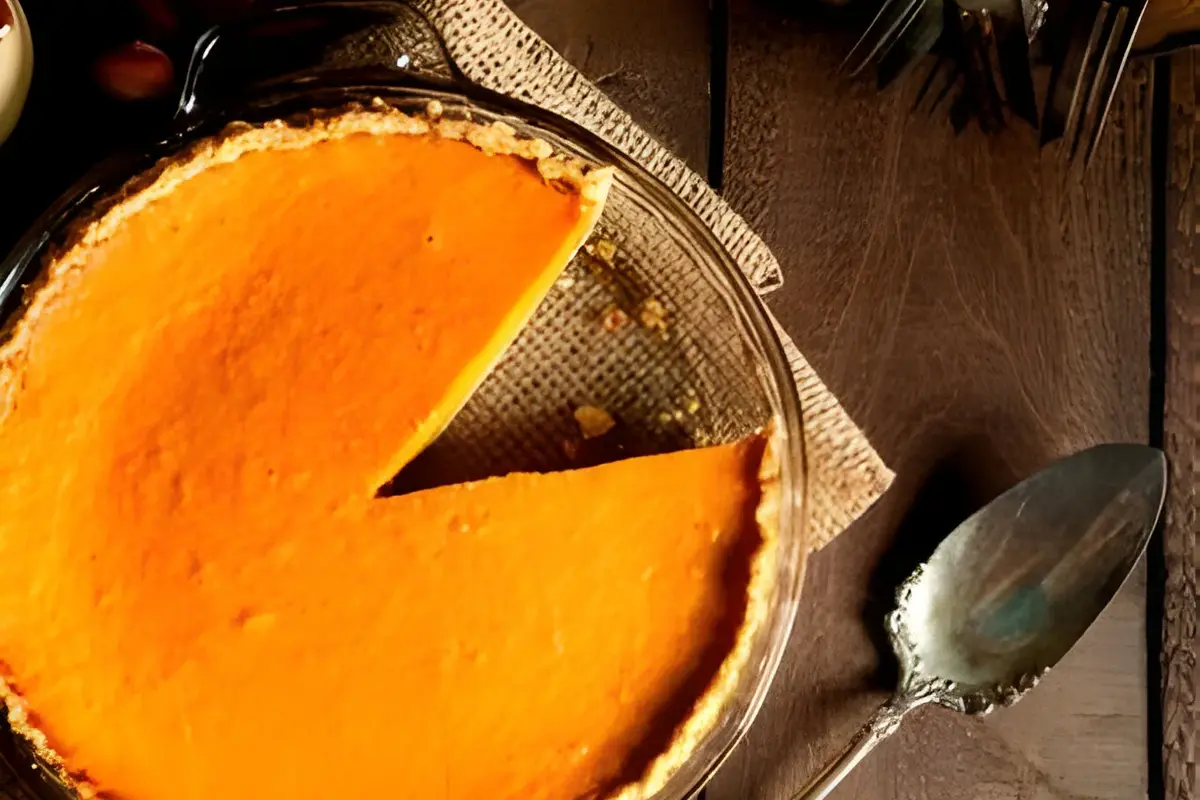Introduction to Sweet Potato Pie: A Staple in Soul Food Cuisine
Sweet potato pie, often heralded as the southern cousin to pumpkin pie, holds a cherished spot in the heart of soul food tradition. This delectable dessert, rich in flavor and history, serves as a centerpiece at many family gatherings, especially during Thanksgiving. Unlike its pumpkin counterpart, potato pie boasts a unique texture and a slightly different set of spices that make it a distinct favorite across various communities, particularly among African-Americans and southern natives.
The Cultural Significance of Sweet Potato Pie
Sweet potato pie transcends mere culinary delight, embedding itself deeply within the fabric of cultural traditions. It’s not just a dessert; it’s a symbol of heritage, comfort, and the warmth of home. The pie’s roots can be traced back to the very essence of soul food cuisine, which is known for its ability to bring people together, offering a taste of shared history and collective memory.
Sweet Potato Pie vs. Pumpkin Pie: A Southern Delicacy
While both sweet potato and pumpkin pies share a similar set of ingredients—like cinnamon, nutmeg, and vanilla—the key difference lies in the main ingredient. Sweet potatoes lend a naturally sweet flavor and a creamy texture that, when combined with the right spices, create a pie that’s both rich and comforting. This distinction not only sets potato pie apart in taste but also in its cultural significance, making it a beloved dish among those who cherish southern cuisine and traditions.
The preparation of sweet potato pie involves a careful blend of spices, including cinnamon and nutmeg, which are used to enhance the natural sweetness of the sweet potatoes. These ingredients, coupled with the smooth texture of butter and the richness of eggs, come together to form a pie that is both flavorful and satisfying. The process, while simple, requires a certain level of precision and care, ensuring that each pie is a testament to the tradition it represents.
Ingredients and Preparation: Crafting the Perfect Sweet Potato Pie
Creating the perfect sweet potato pie involves a harmonious blend of ingredients and a careful preparation process. At its core, the pie combines the sweetness of orange-fleshed sweet potatoes with a rich mix of spices and essentials that elevate it to a dessert beloved by many.
Essential Ingredients for Sweet Potato Pie
The journey to a delicious potato pie begins with its star ingredient: the sweet potato. Orange-fleshed sweet potatoes are preferred for their natural sweetness and smooth texture, which form the base of the pie. To this, softened butter and eggs are added, contributing to the pie’s creamy consistency and rich flavor. The spice blend, typically consisting of cinnamon and nutmeg or allspice, infuses the pie with warmth and depth. Vanilla extract rounds out the flavor profile, adding a hint of aromatic sweetness that complements the earthiness of the sweet potatoes.
Spices and Flavorings: Cinnamon, Nutmeg, and Vanilla
The choice of spices in sweet potato pie is no small matter. Cinnamon and nutmeg, or the alternative allspice, are not just ingredients; they are the soul of the pie, offering layers of flavor that resonate with warmth and comfort. Vanilla extract acts as the perfect counterbalance, enhancing the natural sweetness of the sweet potatoes and bringing a subtle complexity to the pie’s overall taste.
Step-by-Step Preparation Guide
- Baking the Sweet Potatoes: The first step involves baking the sweet potatoes until they are soft and squishy, which usually takes about 90 minutes. This method ensures that the sweet potatoes are fully cooked and easy to mash, providing a smooth base for the pie filling.
- Mixing the Filling: Once the sweet potatoes are prepared, they are mashed and mixed with the softened butter, eggs, and sugar. This mixture is then blended with the spices and vanilla extract, followed by the gradual addition of evaporated milk to achieve the perfect consistency.
- Baking the Pie to Perfection: The filling is poured into deep dish pie shells and smoothed out before baking. The pie is baked at 375°F for about 70 minutes, until the filling is set and the crust is golden brown. Allowing the pie to cool before serving is crucial, as it helps the flavors to meld together beautifully.
Variations and Serving Suggestions: Personalizing Your Sweet Potato Pie
Creative Variations of Sweet Potato Pie
For those looking to add a twist to the traditional recipe, experimenting with spices and flavors can yield delightful results. Consider incorporating a pinch of cardamom or a dash of clove for an unexpected flavor profile. For a healthier version, substituting the sugar with maple syrup or honey can add depth and reduce processed sugar intake. Gluten-free and vegan options are also achievable by substituting the pie crust with a gluten-free alternative and using plant-based ingredients for the filling, ensuring everyone can enjoy this delicious dessert regardless of dietary restrictions.
Gluten-Free and Vegan Options
Creating a gluten-free potato pie involves using a gluten-free pie crust, which can be homemade or store-bought. For the vegan version, replacing eggs with flaxseed or chia seed mixture and using vegan butter ensures the pie remains plant-based. These adaptations not only make the pie accessible to more people but also introduce new textures and flavors.
Serving and Presentation Tips
Presentation plays a crucial role in serving sweet potato pie. A dollop of whipped cream or a sprinkle of cinnamon on top can make each slice visually appealing. Serving the pie at the right temperature is also key; while some prefer it warm, allowing the pie to cool down completely can enhance its flavors and texture. Accompaniments like vanilla ice cream or a side of warm custard can turn a simple slice of pie into a decadent dessert.
Accompaniments and Toppings
The choice of accompaniments and toppings can transform sweet potato pie into an even more indulgent treat. For a festive touch, a sprinkle of toasted pecans or a drizzle of caramel sauce can add texture and sweetness. For those who enjoy contrast, a side of tangy berry compote can cut through the pie’s richness, offering a refreshing balance.
Nutritional Information: The Health Benefits of Sweet Potato Pie
Nutritional Components of Sweet Potatoes
Sweet potatoes are rich in vitamin A, vitamin C, and manganese. They also provide impressive amounts of fiber, which aids in digestion. These nutrients support eye health, boost immunity, and promote healthy skin. Including sweet potatoes in your diet, even as part of a dessert like sweet potato pie, contributes to a balanced intake of essential vitamins and minerals.
Caloric and Sugar Content: A Balanced View
While sweet potato pie is a dessert, its sugar and caloric content can be managed. The natural sweetness of sweet potatoes allows for less added sugar. Moderation is key. Enjoying a slice of pie can fit into a balanced diet. It’s about the joy of eating without overindulgence.
Creative Variations and Serving Suggestions
Sweet potato pie is versatile. Here, we explore ways to personalize this classic dessert. We also offer tips for serving it in style.
Experimenting with Spices and Flavors
Firstly, don’t hesitate to experiment. Add ginger or clove for a twist. These spices introduce new flavors, making each pie unique.
Gluten-Free and Vegan Options
Secondly, adapt the recipe for dietary needs. Use gluten-free crusts for a gluten-free version. For vegans, replace dairy and eggs with plant-based alternatives. These changes ensure everyone enjoys the pie.
Accompaniments and Toppings
Thirdly, consider the toppings. Whipped cream or a sprinkle of cinnamon makes the pie even more enticing. Serve warm or cold, based on preference.
Serving Sweet Potato Pie: Temperature and Timing
Lastly, timing matters. Serve the pie at room temperature for the best texture. If you prefer it warm, a few minutes in the oven does the trick.
Preserving and Storing
Proper storage extends the life of the potato pie. Here, we share tips to keep your pie fresh longer.
Cooling Before Storage
First, let the pie cool completely. This prevents condensation inside the container. Moisture can make the crust soggy.
Refrigerating Your Pie
Next, refrigerate the pie. Use an airtight container to keep it fresh. This method works well for up to four days.
Freezing for Long-Term Storage
Additionally, you can freeze the pie. Wrap it tightly in plastic wrap, then in foil. Frozen pie lasts up to two months. Thaw in the refrigerator before serving.
Reviving Leftovers
Finally, to revive leftovers, warm them slightly in the oven. This restores the crust’s crispness and the filling’s warmth.
These storage tips ensure your pie remains delicious. Whether enjoying it the next day or weeks later, proper preservation keeps the flavors intact. Enjoy your pie as if it were freshly baked, anytime.
Frequently Asked Questions
Sweet potato pie enthusiasts often have questions about this beloved dessert. Here, we address the most common inquiries, providing clear and concise answers.
What are the main spices used in sweet potato pie?
Cinnamon and nutmeg are the main spices. They add warmth and depth to the pie.
Can sweet potato pie be made vegan?
Yes, you can make sweet potato pie vegan. Use plant-based butter and milk. Substitute eggs with flaxseed or chia seeds.
How long does sweet potato pie last in the fridge?
The pie lasts up to 4 days in the fridge. Keep it covered to maintain freshness.
Is sweet potato pie healthier than pumpkin pie?
Sweet potato pie can be healthier. It depends on the ingredients. Sweet potatoes offer more fiber and vitamins.


